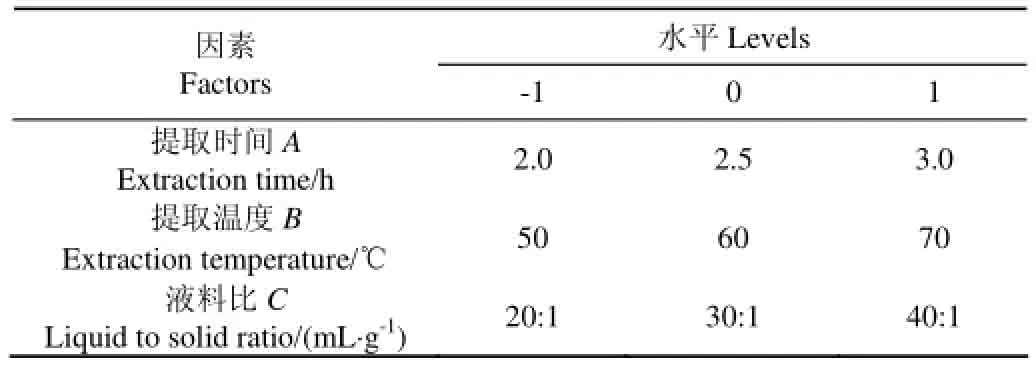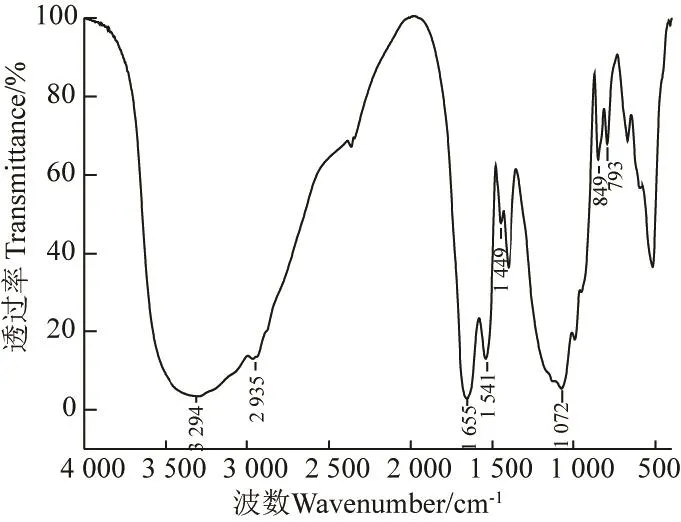南瓜籽多糖热水提取工艺优化及其抗氧化活性
2016-12-19王丽波徐雅琴王泰恒李鲁滨王瀚嵩
王丽波,程 龙,徐雅琴,王泰恒,李鲁滨,王瀚嵩
(东北农业大学理学院,哈尔滨 150030)
南瓜籽多糖热水提取工艺优化及其抗氧化活性
王丽波,程 龙,徐雅琴※,王泰恒,李鲁滨,王瀚嵩
(东北农业大学理学院,哈尔滨 150030)
为开发利用南瓜籽中多糖资源,基于前期水提醇沉制得南瓜籽多糖的研究基础上,该文进一步探讨了热水浸提法提取南瓜籽多糖工艺参数并对其结构进行了初步分析。结果表明:南瓜籽多糖的最佳提取条件为提取温度60℃、提取时间2.5 h、液料比40:1 mL/g,此条件下多糖得率的预测值为2.25%,实际验证值为2.18%。初步分析南瓜籽多糖由鼠李糖、阿拉伯糖、木糖、甘露糖、葡萄糖和半乳糖6种单糖组成,摩尔比为0.52∶0.88∶0.73∶0.14∶1.00∶1.12,不含糖醛酸,为中性杂多糖。体外抗氧化活性试验表明,南瓜籽多糖对DPPH·、·OH和O2-· 3种自由基均具有一定的清除效果,多糖质量浓度为1.0 mg/mL时,清除率分别达到21.3%±0.14%、57.14%±0.28%和40.50%±0.64%。研究结果为后续南瓜籽多糖纯品制备、结构表征提供了基础,为提高南瓜籽相关保健品附加值提供了一定理论依据。
提取;工艺;优化;南瓜籽;多糖;抗氧化活性
0 引言
南瓜籽,又名白瓜子、金瓜子、南瓜仁,是葫芦科植物南瓜(Cucurbita moschata Duch)的成熟种子。南瓜籽中含有丰富的脂肪、蛋白质、甾醇以及各种矿物质等营养成分[1-4],具有驱虫、消炎、止痛等功效,可用于治疗绦虫、蛔虫,产后手足浮肿、百日咳等疾病[5-7],长期食用具有保健和防病治病的功效。南瓜在中国种植历史悠久、种植面积广泛、产量居世界第一位,目前南瓜籽产量也在逐年上升,南瓜籽已被公认为保健食品,日益受到消费者的重视,所以开发南瓜籽新产品,提高南瓜籽的附加值具有广阔的发展前景。
多糖,又称多聚糖,是由10个以上的单糖通过糖苷键连接而成的一种高分子化合物。它是调控生物体生长发育的一种重要的大分子化合物。大量研究表明多糖具有多种药理活性,如调节机体免疫力、抗氧化、降血糖、抗肿瘤、抗辐射和抗衰老等作用[8-11],且具有毒副作用小、安全性高等优点,因此,多糖类物质的研究与开发一直是近年来的研究热点。
目前,已有很多文献表明南瓜果肉中多糖具有降血糖、抗氧化、抗肿瘤以及抑菌活性[12-15],但对于南瓜籽中多糖成分尚未给予更多关注,本课题组前期研究已表明,南瓜籽中含有一定量的非淀粉类多糖成分,经过热水提取、乙醇沉淀可以制得南瓜籽多糖[16],在前期研究基础上,本文以蒸馏水为提取溶剂,通过单因素试验考察提取温度、提取时间及液料比3个因素对南瓜籽多糖得率的影响,在此基础上利用中心组合设计响应面分析法对多糖提取工艺进行优化筛选,旨在探求热水法提取南瓜籽多糖的适宜工艺条件。同时测定南瓜籽多糖的组成和抗氧化活性,为进一步深入开展南瓜籽多糖生物活性及构效关系的研究提供参考。
1 材料与方法
1.1 材料与仪器
宝库1号裸仁南瓜籽(Semen Moschatae):讷河市宝库良种繁育研究所;阿拉伯糖、木糖、岩藻糖、鼠李糖、半乳糖、葡萄糖、甘露糖、肌醇均为生化试剂:美国Sigma公司;色谱纯吡啶:天津光复精细化工研究院;分析纯乙酸酐:天津科密欧化学试剂有限公司;色谱纯三氟乙酸:上海凌峰化学试剂有限公司;分析纯1,1-二苯基-2-苦基肼(DPPH, 2,2-diphenyl-1-(2,4,6-trinitrophenyl)hydrazyl);阿拉丁化学试剂有限公司;维生素C、邻苯三酚、硫酸亚铁、过氧化氢均为分析纯。
HHS-2S型电子恒温水浴锅:上海必尔得仪器实业有限公司;LD4-2型离心机:北京医用离心机厂;R-205型旋转蒸发仪:上海申胜生物技术有限公司;TU 1901 型双光束紫外可见分光光度计:北京普析通用仪器有限责任公司;GC-2010 plug型气相色谱仪:日本岛津公司;FDU-1100型冷冻干燥机:日本Eyela公司;FTS135型傅立叶变换红外光谱仪:美国BID-BAD公司。
1.2 试验方法
1.2.1 多糖含量测定
采用苯酚-硫酸法测定南瓜籽中多糖含量[17]。以葡萄糖为标准品,于490 nm处测定,以葡萄糖质量浓度x为横坐标(mg/L),吸光度A为纵坐标,绘制标准曲线。所得回归方程:y=0.0123x‒0.0016(R2=0.9984)式中:y为吸光度。
1.2.2 南瓜籽多糖的提取工艺流程
南瓜籽→粉碎(过80目筛)、烘干(60℃、24 h,含水率为2.0%)→乙醚脱脂(索氏抽提,50℃回流48 h)→热水浸提(3.0 g脱脂南瓜籽粉,选择合适的提取时间、提取温度、液料比)→离心(4 000 r/min,15 min)→上清液旋转蒸发→80%醇沉(4倍体积的体积分数为95%乙醇,4℃静置12 h)→离心(4 000 r/min,10 min)→得沉淀(乙醇、丙酮各洗涤2次)→真空冷冻干燥(‒50℃,真空度<15 Pa,干燥24 h)→南瓜籽粗多糖[16]。
1.2.3 多糖得率的计算公式

1.2.4 南瓜籽多糖提取单因素试验
称取3.0 g脱脂南瓜籽粉,以蒸馏水作为溶剂,进行提取时间、提取温度和液料比对多糖得率影响的单因素试验。在提取温度60℃、液料比30∶1 mL/g条件下,提取时间分别取1.0、1.5、2.0、2.5、3.0 h;在液料比30:1 mL/g、提取时间2.5 h条件下,提取温度分别取30、40、50、60、70℃;在温度60℃、提取时间2.5 h条件下,液料比取值10∶1、20∶1、30∶1、40∶1、50∶1 mL/g。
1.2.5 提取工艺的响应面优化试验
在单因素试验的基础上,选以提取时间(A,h)、提取温度(B,℃)和液料比(C,mL/g)为自变量,以南瓜籽多糖得率Y(%)为响应值,根据Box-Behnken中心组合试验原理,设计三因素三水平响应面分析[18-20]试验。其因素水平编码表见表1。

表1 Box-Behnken试验因素水平及编码水平表Table1 Factors and levels of Box-Behnken experiment design
1.2.6 抗氧化活性
1)南瓜籽多糖清除DPPH自由基活性测定
取不同质量浓度多糖溶液(0.2、0.4、0.6、0.8、1.0 mg/mL)各2 mL于试管中,加入0.3 mol/L DPPH 2 mL,避光反应30 min,于517 nm波长处测定吸光度(Ai);再取上述多糖液2 mL,加入2 mL无水乙醇,反应30 min,于517 nm波长处测定吸光度(Aj);取2 mL DPPH,加入2 mL无水乙醇,反应30 min测定吸光度(A0)。每个浓度的样品平行测定3次取平均值。以维生素C做阳性对照,清除率计算公式如下

式中Ai为加多糖溶液反应的吸光度;Aj为多糖溶液自身的吸光度;A0为DPPH溶液自身的吸光度。
2)南瓜籽多糖清除羟自由基(·OH)活性测定
取不同质量浓度(0.2、0.4、0.6、0.8、1.0 mg/mL)的南瓜籽多糖溶液2 mL。一次加入FeSO4(6 mmol/L),H2O2溶液(6 mmol/L)各2 mL,混匀,静置10 min;再加入6 mmol/L的水杨酸溶液2 mL,混匀,静置30 min后;在波长510 nm处测定其吸光度Ai’,用蒸馏水代替水杨酸测定吸光度Aj′。空白对照组以蒸馏水代替多糖溶液,测定吸光度A0′,平行测定3次。按照公式计算清除率[21]

式中Ai′为加多糖溶液反应的吸光度;Aj′为多糖溶液自身的吸光度;A0′为·OH溶液自身的吸光度。
3)南瓜籽多糖清除超氧阴离子自由基(O2-·)活性测定
采用邻苯三酚自氧化法测定南瓜籽多糖对O2-·的清除能力。加0.05 mol/L的Tris-HCL(pH 值8.2)4.5 mL于试管中,置于25℃水浴20 min,加入不同质量浓度(0.2、0.4、0.6、0.8、1.0 mg/mL)的南瓜籽多糖溶液或维生素C溶液0.4 mL和25℃的邻苯三酚(10 mmol/L HCL溶液配制)80 μL。加入后快速摇匀,测定325 nm波长处的吸光度值,每隔0.5 min记录一次,连续记录4 min,平行测定3次,计算各管的氧化速率及对O2-·的清除率。

式中A0″为未加多糖溶液反应的吸光度;At″为加多糖溶液反应的吸光度。
1.2.7 气相色谱分析
采用糖腈乙酰酯衍生气相色谱测定单糖组成,具体方法参照文献[16]。
1.2.8 红外光谱分析
称取1~2 mg经冷冻干燥的多糖样品与已干燥的KBr在研钵中研磨均匀,压片。在4 000~500 cm-1范围内进行红外光谱扫描。
1.3 数据处理方法
所有试验均进行3次重复,结果表示为平均值±标准偏差(mean±SD),试验数据处理和分析采用Excel 2013、Design-Expert 8.0及OriginPro 9.0软件。
2 结果与分析
2.1 南瓜籽多糖提取单因素试验
称取3.0 g脱脂南瓜籽粉,以蒸馏水作为提取溶剂,研究提取时间、提取温度和液料比对南瓜籽多糖得率的影响,结果见图1。

图1 提取时间、提取温度、液料比对南瓜籽多糖得率的影响Fig.1 Effects of extraction time, extraction temperature and liquid to solid ratio on extraction yield of polysaccharides
由图1a可知,在提取时间小于2.5 h时,南瓜籽多糖得率随提取时间的增加而升高;在2.5 h时,南瓜籽多糖得率达到最大。当提取时间进一步增加时,多糖得率呈下趋势,这可能是提取时间过长对多糖的稳定性产生了影响。考虑到提取工艺的能耗和效率,选择提取时间2.0~3.0 h为宜。由图1b可知,在30~60℃范围内随温度的上升,多糖得率显著增加(P<0.05),但在超过60℃以后,多糖得率呈下降趋势,说明温度因素可能对南瓜籽多糖的降解作用明显,因此提取温度不宜过高,本试验选取50~70℃为宜。由图1c可知,多糖得率随着液料比由10∶1 mL/g增加到20∶1 mL/g时显著上升(P<0.05),在20∶1~40∶1 mL/g之间多糖得率基本不变,但在超过40∶1 mL/g时,得率出现下降趋势,液料比越大,后期离心、醇沉等处理步骤所造成多糖损失会越多,因此选取液料比为20∶1~40∶1 mL/g为较优水平进行下一步响应面分析。
2.2 南瓜籽多糖提取工艺的优化
2.2.1 响应面试验方案及结果
应用响应面法对过程进行优化。以提取时间A、提取温度B、液料比C为自变量,以南瓜籽多糖得率Y为响应值,响应面试验方案及结果见表2。
通过利用Design-Expert 8.0软件中的Box-Behnken选项对表2数据进行多元回归拟合,获得南瓜籽多糖提取率Y(%)对自变量提取时间A(h)、提取温度B(℃)和液料比C(mL/g)的二次多项回归方程,对表2结果进行统计分析,可建立如下二次回归方程:

对二次回归方程进行方差分析,结果见表3。由表3可知,B,AC,B2为显著性影响因素,提取温度(B)对多糖得率影响最大。以南瓜籽多糖得率为响应值建立的试验模型高度显著(P=0.0001),而误差项不显著,表明本模型对试验拟合程度较好,回归方程显著,可以较好地表示各影响因素与响应值之间的确定关系,因此利用该方程可以确定南瓜籽多糖提取的最佳优化工艺。

表2 响应面分析方案及结果Table 2 Experiment design and results of response surface method analysis
2.2.2 南瓜籽多糖最佳提取条件确立和试验验证
在选取的各因素范围内,根据回归模型通过Design-Expert 8.0软件分析得出南瓜籽多糖最佳提取条件为:提取时间2.75 h,提取温度60.61℃,液料比40∶1 mL/g,南瓜籽多糖得率预测值为2.25%。考虑到实际操作的便利,确定南瓜籽多糖提取工艺条件为:提取时间2.5 h,提取温度60℃,液料比40∶1 mL/g。为了证实预测结果,用修正后的最佳提取工艺条件重复试验3次,得到平均多糖得率为2.18%,与预测值误差仅为0.07%,说明应用响应面法优化南瓜籽多糖提取工艺条件具有实际应用价值。

表3 回归方程方差分析表Table 3 Variance analysis of regression equation
2.3 南瓜籽多糖抗氧化活性研究
南瓜籽多糖对DPPH·、·OH和O2-·3种自由基的清除效果见图2,由图2a可以看出,南瓜籽多糖具有一定的清除DPPH自由基的能力,清除能力随样品浓度的增大而升高,但和维生素C比较,南瓜籽多糖在质量浓度为1.0 mg/mL时,清除率仅为21.32%±0.14%,而维生素C达到了93.56%±0.82%。由图2b可知,南瓜籽多糖清除·OH的能力随着质量浓度增加而增强,尽管在相同质量浓度下,南瓜籽多糖对·OH清除活性低于同质量浓度的维生素C,但其清除能力呈现较好的量效关系。多糖质量浓度为1.0 mg/mL时,·OH清除率为57.14%±0.28%。南瓜籽多糖对O2-·同样具有一定的清除能力,但弱于同等浓度下的维生素C清除能力,在1.0 mg/mL时,南瓜籽多糖对O2-·清除率达到了40.50%±0.64%。

图2 南瓜籽多糖对DPPH·、·OH和O2-·的清除作用Fig.2 Antioxidant activities of polysaccharides on DPPH scavenging activity, hydroxyl radical scavenging activity, superoxide anion scavenging activity
2.4 南瓜籽多糖的单糖组成分析
在相同色谱条件下,保留时间可作为定性分析的依据,通过与标准单糖的保留时间相比较,可确定多糖样品中的单糖组分。标准单糖衍生物的气相色谱图见图3a,南瓜籽多糖的气相色谱图见图3b。
气相色谱分析结果表明,南瓜籽多糖是由6种单糖组成的杂多糖,分别为鼠李糖、阿拉伯糖、木糖、甘露糖、葡萄糖和半乳糖,摩尔比为0.52:0.88:0.73:0.14:1.00:1.12。
2.5 南瓜籽多糖的红外光谱分析
由图4可知,南瓜籽多糖在4000~500 cm-1范围内有明显的多糖特征吸收峰。3 294 cm-1处有一宽吸收峰,表明分子内或分子间存在氢键,是由于O-H与N-H的伸缩引起的[10];2935处的小肩峰和1 449处的吸收峰为C-H伸缩振动和弯曲振动的特征峰[22];1 655和1 541 cm-1吸收峰是酰胺基C=O伸缩振动和N-H变角振动[16]。在1 072~996 cm-1间出现3个较强吸收峰,表示存在吡喃糖苷[23];793 cm-1处峰是由吡喃糖的α-端基差向异构体的C-H变角振动引起,在849 cm-1处峰是由β-端基差向异构体的C-H变角振动引起[24]。另外在1 730 cm-1附近没有糖醛酸的特征吸收峰[25],表明南瓜籽多糖是中性杂多糖,不含糖醛酸。

图3 标准单糖和南瓜籽多糖水解单糖的衍生物气相色谱图Fig.3 GC profile of standard monosaccharides and pumpkin seed polysaccharides with acid hydrolysis and acetylation

图4 南瓜籽多糖红外吸收光谱图Fig.4 IR spectra of pumpkin seed polysaccharides
2.6 成本分析及应用前景
目前,在食品工业中南瓜籽主要应用于生产具有保健功能的南瓜籽油,而南瓜籽榨油后的副产物南瓜籽粕主要直接做廉价饲料或作为酱油生产辅料,利用率不高。按照本研究采用的热水提取工艺,提取时间为2.5 h、提取温度为60℃、液料比为40:1 mL/g的条件下,每100 g南瓜籽粕可制得11.9 g南瓜籽粗多糖产品,其中多糖质量分数为18.3%。每生产1 t南瓜籽粗多糖产品,南瓜籽粕原料成本约1.0万(1 200元/t),加工成本(包括水、电、气、人工费、设备折旧费等)约0.8万元,总生产成本约为1.8万元,成本较低。该工艺以蒸馏水作萃取剂不产生有机溶剂残留,满足了目前广大消费者对天然健康食品的要求。而且条件温和,操作简单,适合工业化生产。含有多糖成分的营养粉剂具有较强抗氧化能力,可用于开发功能营养胶囊、片剂等等高附加值产品,也可用于功能饮料、保健型面包等功能营养食品,由此可见,南瓜籽粕采用热水提取法所制得多糖产品市场发展前景非常广阔。
3 结论
1)通过响应面分析法确定南瓜籽多糖的提取的最佳工艺为:以蒸馏水为溶剂,提取时间2.5 h、提取温度60℃、液料比40∶1 mL/g,此条件下多糖得率为2.18%,模型预测值2.25%,误差仅为0.07%。说明采用响应面分析法优化得到的提取工艺参数准确、可靠,具有较好的实用价值。
2)南瓜籽多糖是中性杂多糖,由鼠李糖、阿拉伯糖、木糖、甘露糖、葡萄糖、半乳糖6种单糖组成,不含糖醛酸。南瓜籽多糖对DPPH·、·OH和O2-·3种自由基均具有良好的清除效果,多糖质量浓度为1.0 mg/mL时,清除率分别达到21.3%±0.14%、57.14%±0.28%和40.50%± 0.64%,是一种具有开发潜力的天然抗氧化剂。
[1] Jiao J, Li Z G, Gai Q Y, et al. Microwave-assisted aqueous enzymatic extraction of oil from pumpkin seeds and evaluation of its physicochemical properties, fatty acid compositions and antioxidant activities[J]. Food Chemistry, 2014, 147(6): 17-24.
[2] 王丽波,徐雅琴,杨昱,等. 南瓜籽油的水酶法提取工艺及产品的理化性质[J]. 农业工程学报,2011,27(10):383-387. Wang Libo, Xu Yaqin, Yang Yu, et al. Aqueous enzymatic extraction of pumpkin seed oil and its physical-chemical properties[J]. Transactions of the Chinese Society of Agricultural Engineering (Transactions of the CSAE), 2011, 27(10): 383-387. (in Chinese with English abstract)
[3] 王丽波,于泽源,徐雅琴,等. 南瓜籽中一种抗真菌蛋白的提取及抗菌活性研究[J]. 中国粮油学报,2013,29(3):63-66. Wang Libo, Yu Zeyuan, Xu Yaqin, et al. Study on extraction and antibacterial activity of antifungal protein in pumpkin seed[J]. Journal of the Chinese Cereals and Oils Association, 2013, 29(3): 63-66. (in Chinese with English abstract)
[4] Stevenson D G, Eller F J, Wang L, et al. Oil and tocopherol content and composition of pumpkin seed oil in 12 cultivars[J]. Journal of Agriculture and Food Chemistry, 2007, 55(10): 4005-4013.
[5] Iwo M I, Insanu M, Dass C A S. Development of immunonutrient from pumpkin (Cucurbita Moschata Duchense Ex. Lamk.) seed[J]. Procedia Chemistry, 2014, 13(12): 105-111.
[6] Veronzi C M, Jorge N. Bioactive compounds in lipid fractions of pumpkin (Cucurbita sp) seeds for use in food[J]. Journal of Food Science, 2012, 77(6): 653-657.
[7] Tsai Y S, Tong Y C, Cheng J T, et al. Pumpkin seed oil and phytosterol-F can block testosterone/prazosin-induced prostate growth in rats[J]. Urology International, 2006, 77(3): 269-274.
[8] Shao P, Chen X X, Sun P L. Chemical characterization, antioxidant and antitumor activity of sulfated polysaccharide from Sargassum horneri[J]. Carbohydrate Polymers, 2014, 105(1): 260-269.
[9] Imbs T I, Skriptsova A V, Zvyagintseva T N. Antioxidant activity of fucose-containing sulfated polysaccharides obtained from Fucus evanescens by different extraction methods[J]. Journal of Applied Phycology, 2015, 27(1): 545-553.
[10] 徐雅琴,宋秀梅,任中杰,等. 黑穗醋栗果实多糖清除自由基活性及结构初步研究[J]. 现代食品科技,2013,29(12):2821-2825. Xu Yaqin, Song Xiumei, Ren Zhongjie, et al. Preliminary identification of free radicial activity and structure of kurikami polysaccharide[J]. Modern Food Science and Technology, 2013, 29(12): 282-2825. (in Chinese with English abstract
[11] 许春平,杨琛琛,郑坚强,等. 植物叶多糖的提取和生物活性综述[J]. 食品研究与开发,2014,35(14):111-114. Xu Chunping, Yang Chenchen, Zheng Jianqiang, et al. Review on extraction and biological activity of polysaccharides from plant leave[J]. Food Reseach and Development, 2014, 35(14): 111-114. (in Chinese with English abstract)
[12] Kostálová Z, Hromádková Z, Ebringerová A, et al. Polysaccharides from the styrian oil-pumpkin with antioxidant and complement-fixing activity [J]. Industrial Crops and Products, 2013, 41(1): 127-133.
[13] 张高帆,苏东洋,张拥军,等. 南瓜多糖对不同糖尿病模型小鼠的降糖作用[J]. 中国食品学报,2014, 14(2):23-27. Zhang Gaofan, Su Dongyang, Zhang Yongjun, et al. The hypoglycemic effect of the pumpkin polysaccharide to the different diabetic model mice[J]. Journal of Chinese Institute of Food Science and Technology, 2014, 14(2): 23-27. (in Chinese with English abstract)
[14] 万艳娟,刘晓娟,赵力超,等. 南瓜多糖抑制α-淀粉酶及抑菌活性的研究[J]. 食品科技,2012,37(3):45-47. Wan Yanjuan, Liu Xiaojuan, Zhao Lichao, et al. The inhibitory effect on α-amylase and antibiotic activity from pumpkin polysaccharide[J]. Food Science and Technology, 2012, 37(3): 45-47. (in Chinese with English abstract)
[15] Song Y, Zhang Y Y, Zhou T T. A preliminary study of monosaccharide compositionand α-glucosidase inhibitory effect of polysaccharides from pumpkin (Cucurbita moschata) fruit[J]. International Journal of Food Science and Technology, 2012, 47(2): 357-361.
[16] 王丽波,徐雅琴,于泽源,等. 南瓜籽多糖的乙醇分级沉淀及超声波改性研究[J]. 农业机械学报,2015,46(8):215-220. Wang Libo, Xu Yaqin, Yu Zeyuan, et al. Ethanol fractional precipitation and ultrasonic modification of pumpkin polysaccharides[J]. Transaction of the Chinese Society for Agricultural Machinery, 2015, 46(8): 215-220. (in Chinese with English abstract)
[17] 池源,王丽波. 苯酚-硫酸法测定南瓜籽多糖含量的条件优化[J]. 食品与机械,2014,30(1):89-92. Chi Yuan, Wang Libo. Study on phenol-sulfuric acid method for determination of polysaccharide content in pumpkin seeds[J]. Food and Machinery, 2014, 30(1): 89-92. (in Chinese with English abstract)
[18] 柯乐芹,张东旭,肖建中. 杏鲍菇深加工残渣多糖酶法微波辅助提取工艺优化[J]. 农业工程学报,2014,30(21):332-338. Ke Leqin, Zhang Dongxu, Xiao Jianzhong. Optimization of microwave-assisted enzyme extraction process of polysaccharide from Pleurotus eryngii stalk residue after deep treatment[J]. Transactions of the Chinese Society of Agricultural Engineering (Transactions of the CSAE), 2014, 30(21): 332-338. (in Chinese with English abstract)
[19] 许键,蔡慧农,倪辉,等. 壳聚糖澄清芦柑果汁工艺条件的优化[J]. 农业工程学报,2013,29(23):268-275. Xu Jian, Cai Huinong, Ni Hui, et al. Optimized conditions for clarification of chitosan on ponkan juice[J]. Transactions of the Chinese Society of Agricultural Engineering (Transactions of the CSAE), 2013, 29(23): 268-275. (in Chinese with English abstract)
[20] Yin X L, You Q H, Su X Y. A comparison study on extraction of polysaccharides from Tricholoma matsutake by response surface methodology[J]. Carbohydrate Polymers, 2014, 102(15): 419-422.
[21] 王振斌,刘加友,马海乐,等. 无花果多糖提取工艺优化及其超声波改性[J]. 农业工程学报,2014,30(10):262-269. Wang Zhenbin, Liu Jiayou, Ma Haile, et al. Extraction process optimization and ultrasonic modification of polysaccharide from Ficus carica L.[J]. Transactions of the Chinese Society of Agricultural Engineering (Transactions of the CSAE), 2014, 30(10): 262-269. (in Chinese with English abstract)
[22] Xie J H, Xie M Y, Nie S P, et al. Isolation, chemical composition and antioxidant activities of a water-soluble polysaccharide from Cyclocarya paliurus (Batal.) Iljinskaja[J]. Food Chemistry, 2010, 119(4): 1626-1632.
[23] Jiang C X, Xiong Q P, Gan D, et al. Antioxidant activity and potential hepatoprotective effect of polysaccharides from Cyclina sinensis[J]. Carbohydrate Polymers, 2013, 91(1): 262-268.
[24] 黎英,陈雪梅,严月萍,等. 超声波辅助酶法提取红腰豆多糖工艺优化[J]. 农业工程学报,2015,31(15):293-301. Li Ying, Chen Xuemei, Yan Yueping, et al. Optimal extraction technology of polysaccharides from red kindey bean using ultrasonic assistant with enzyme[J]. Transactions of the Chinese Society of Agricultural Engineering (Transactions of the CSAE), 2015, 31(15): 293-301. (in Chinese with English abstract)
[25] Yu Z Y, Liu L, Xu Y Q, et al. Characterization and biological activities of a novel polysaccharide isolated from raspberry (Rubus idaeus L.) fruits[J]. Carbohydrate Polymers, 2015, 132(68): 180-186.
Extraction technology optimization and antioxidant activity of polysaccharides from pumpkin seeds
Wang Libo, Cheng Long, Xu Yaqin※, Wang Taiheng, Li Lubin, Wang Hansong
(College of Science, Northeast Agricultural University, Harbin 150030, China)
Pumpkin seeds are rich in lipids, proteins, phytosterols, vitamins, minerals and other valuable components. In recent years, many researches have showed pumpkin seeds can significantly reduce serum cholesterol and triglycerides, and play a role in the prevention and mitigation of cardiovascular disease as well as in preventing prostate disease. It has been found that natural polysaccharides extracted from plant seeds possess various important biological activities, such as anti-cancer, antioxidant, immunization and hypolipidemic activities. However, there is not much published information on polysaccharides in pumpkin seeds. For the development and utilization of polysaccharides in pumpkin seeds, at present, degreased pumpkin seed powder was used as raw material, and the extraction of polysaccharides was mainly performed by hot-water extraction. The optimum extraction technology was studied and the preliminary structure of polysaccharides was analyzed by using infrared spectrum scanning (IR) and gas chromatography (GC). Taking polysaccharide yield as an index, the effects of extraction time, extraction temperature, liquid-solid ratio were studied through the single-factor experiment. And then on the basis of single-factor experiment, the optimum extraction condition was investigated with the response surface methodology (RSM) according to the Box-Behnken center combination design principle by the Design-Expert 8.0 software. The results showed that the optimum parameters were: extraction time 2.5 h, extraction temperature 60 °C, liquid-solid ratio 40:1 mL/g, and the extraction yield of pumpkin seed polysaccharides was 2.25%. Under this condition, the actual value was 2.18%, which was closely matched with the predicted yield. The result showed that, the developed model was adequate and precise when compared with experimental data. The monosaccharide composition of polysaccharide was analyzed through comparing the retention time against the standards by GC. Composition analysis indicated that the polysaccharides were composed of rhamnose, arabinose, xylose, mannose, glucose and galactose with a mole ratio of 0.52 : 0.88 : 0.73 : 0.14 : 1.00 : 1.12. The IR spectrum showed that pumpkin seed polysaccharide exhibited the typical absorption peaks of a polysaccharide within the wave number of 4000-500 cm-1. Three strong absorption peaks of polysaccharide within the range of 1072-996 cm-1indicated the possible presence of pyranose ring in polysaccharides. There was no peak at 1730 cm-1of COOH, which showed that polysaccharides were neutral heteropolysaccharide with the absence of uronic acid. The antioxidative assays in vitro showed that polysaccharides presented certain scavenging activity toward DPPH·, HO·, and O2-·. The scavenging activity was increased with the increasing of the sample concentration within the test dosage range. At the same test concentration, the scavenging effects of polysaccharide against these 3 radicals were slightly lower than ascorbic acid. The scavenging rate of polysaccharide was respectively 21.3%±0.14%, 57.14%±0.28% and 40.50%±0.64% at the mass concentration of 1.0 mg/mL. In the future, pumpkin seed polysaccharides might be expected to play a promising role as dietary free radical scavengers for oxidative damage prevention. The experimental results provide the basis for the further preparation of pure polysaccharide product, the structure characterization and the biological activity determination. At the same time, this study provides the theoretical basis for the further development of the pumpkin seed function and the improvement of the added value of nonfat pumpkin seed cake.
extraction; technology; optimization; pumpkin seeds; polysaccharides; antioxidant activity
10.11975/j.issn.1002-6819.2016.09.040
TS218
A
1002-6819(2016)-09-0284-07
王丽波,程 龙,徐雅琴,王泰恒,李鲁滨,王瀚嵩. 南瓜籽多糖热水提取工艺优化及其抗氧化活性[J]. 农业工程学报,2016,32(9):284-290.
10.11975/j.issn.1002-6819.2016.09.040 http://www.tcsae.org
Wang Libo, Cheng Long, Xu Yaqin, Wang Taiheng, Li Lubin, Wang Hansong. Extraction technology optimization and antioxidant activity of polysaccharides from pumpkin seeds[J]. Transactions of the Chinese Society of Agricultural Engineering (Transactions of the CSAE), 2016, 32(9): 284-290. (in Chinese with English abstract) doi:10.11975/j.issn.1002-6819.2016.09.040 http://www.tcsae.org
2015-11-21
2016-02-05
黑龙江省自然科学基金面上项目(C2015004)。
王丽波,女,博士,副教授。研究方向:天然产物提取及活性研究。哈尔滨 东北农业大学理学院,150030。Email:wanglibo99166@163.com
※通信作者:徐雅琴,女,教授。研究方向:天然产物提取及活性研究。哈尔滨 东北农业大学理学院,150030。Email:xu-yaqin@163.com
